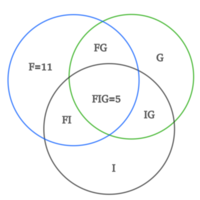Hey guys, can you please help me solve this problem:
In Prime High School, there are 3 language classes - Italian, German and French.
There are 40 students in each class.
11 students study only French, 12 students study only German and Italian and only 5 students study all 3 languages.
How many students study only Italian at Prime High School?
Thanks
In Prime High School, there are 3 language classes - Italian, German and French.
There are 40 students in each class.
11 students study only French, 12 students study only German and Italian and only 5 students study all 3 languages.
How many students study only Italian at Prime High School?
Thanks

